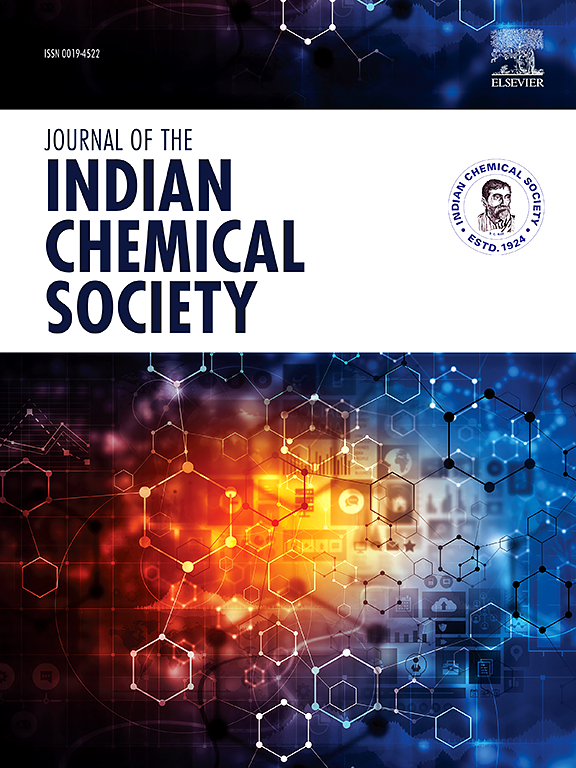多酸溶液消解(MASD)火焰原子吸收光谱法测定选定食品样品中特定金属的外观
IF 3.2
4区 化学
Q2 CHEMISTRY, MULTIDISCIPLINARY
引用次数: 0
摘要
不同的生活方式使人们依赖于特定的食物类型,没有均衡的饮食来源,这可能导致许多疾病。因此,有必要确定这些金属在其实际样品中的浓度,作为不同生活方式的食物来源,可以将食物摄入类型(生活方式)与其中金属的浓度联系起来,从而可以预测每种生活方式将遭受的疾病。在植物、鱼类和动物等实际样品中检测到6种重金属离子(Fe(III)、Cd(II)、Cu(II)、Ni(II)、Pb(II)和Cr(III))。采用酸性消化(MASD)法进行鉴定,火焰原子吸收光谱法具有较高的准确度、灵敏度和检测微量金属成分的能力。肺组织中铁的最高浓度从15.750 ppm到0.255ppm不等,而眼组织中的铅浓度从0.689 ppm到0.073 ppm不等。口腔组织中铬的浓度在0.024 - 0.700 ppm之间,铜的浓度在0.109 - 0.021 ppm之间,肺组织中沉积的量最大。脑组织中镍含量在0.284 ~ 0.198 ppm之间。最后,镉含量在0.038到1.094 ppm之间。在肉类组织中发现的浓度最高。水稻和黑穗病中未发现铅。受污染的环境可能导致大多数金属在牛肺组织中积聚。采用单因素方差分析(ANOVA)、标准差、p值进行统计分析。讨论了一些统计参数,如每日推荐摄取量等。本文章由计算机程序翻译,如有差异,请以英文原文为准。

Assessing the Appearance of specific metals in select food samples via flame atomic absorption spectroscopy using multi-acidic solutions digestion (MASD)
Different life style make people depends on definite type of food without a balanced dietary sources which may cause many diseases. So, it is necessary to determine the concentration of these metals in its real samples as food source for different life style to can connect between type of food intake (life style) and the concentration of its metal in it which can predict the diseases which each category of life style will be suffer from. Six heavy metals ions (Fe(III), Cd(II), Cu(II), Ni(II), Pb(II) and Cr(III)) were detected in some real samples as plant, fish and animal samples. All were digested via acidic digestion (MASD) method to identify using flame atomic absorption spectroscopy due to it is highly accurate, sensitive and capable of detecting metallic components in minute concentrations. The greatest concentrations of iron ranged from 15.750 to 0.255ppm in lung tissues, whereas lead concentrations varied from 0.689 to 0.073 ppm in eye tissue. The concentration of chromium ranged from 0.024 to 0.700 ppm in oral tissues, while copper was from 0.109 to 0.021 ppm, with the maximum quantity deposited in lung tissue. In addition to amount of nickel was from 0.284 to 0.198 ppm in brain tissue. Finally, cadmium level ranged between 0.038 and 1.094 ppm. The highest concentration was found in meat tissues. No presence for lead in rice and nigella sativa. A polluted environment may result in the buildup of most metals in bovine lung tissues. Many statistical analyses were conducted using ANOVA Single Factor with mean, standard deviations, p-value. Some statistical parameters were discussed as recommended daily allowances (RDA) and others.
求助全文
通过发布文献求助,成功后即可免费获取论文全文。
去求助
来源期刊
CiteScore
3.50
自引率
7.70%
发文量
492
审稿时长
3-8 weeks
期刊介绍:
The Journal of the Indian Chemical Society publishes original, fundamental, theorical, experimental research work of highest quality in all areas of chemistry, biochemistry, medicinal chemistry, electrochemistry, agrochemistry, chemical engineering and technology, food chemistry, environmental chemistry, etc.

 求助内容:
求助内容: 应助结果提醒方式:
应助结果提醒方式:


